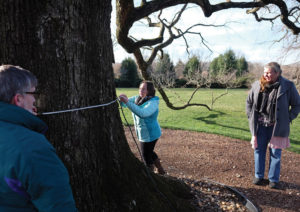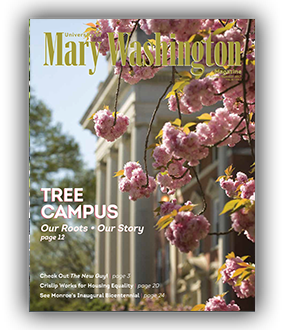
Elizabeth Piña ’18 uses a specialized tape measure to determine the diameter of the Brompton Oak. Professor of Biology Alan Griffith, at left, helps measure as Joni Wilson looks on. (Photo by Norm Shafer)
On a cold winter morning, biology major Elizabeth Piña ’18 and Associate Professor of Biology Alan Griffith met on the lawn at Brompton to determine just how big the Brompton Oak really is.
As teams of students have done for hundreds of other campus trees, they used specialized tools to determine the massive oak’s height; crown spread; and DBH, or diameter at breast height.
Eventually, that data will be correlated to one red square among hundreds on an image map of the Fredericksburg campus, including Brompton and the athletic fields. Each square represents a single tree; viewers will click on it to see data that has been meticulously gathered and catalogued.
Griffith conceived the mapping project two years ago in collaboration with Director of Landscape and Grounds Joni Wilson ’00, who didn’t have the budget or staff to gather the necessary data. Griffith realized he could not only help Wilson and UMW, he could also use the project to engage students in service learning. Working in teams, student technicians apply accepted techniques of measuring a tree.
Over four semesters, 14 students have worked on the project either as volunteers or for research credit, Griffith said. They’ve collected data about many of the “heritage trees” on campus –
those significant because of their history, their contribution to plant diversity, or their location in the landscape.
Griffith’s project and a related effort by Fredericksburg Tree Stewards and Central Rappahannock Master Naturalists have yielded information that may guide decisions about which species of new or replacement trees should be planted on campus.
The data may eventually be used to estimate how much rainwater UMW’s trees absorb and how much carbon dioxide they convert. It’s also helpful to know what species of animals or other plant life the campus trees support.
From an economic point of view, the information provides a record of each tree and a way to measure a tree’s worth besides merely calculating the board-foot value of its wood.
It’s also been valuable for the students involved, Griffith said, helping to introduce them to the growing field of urban ecology. They’ve had the experience of contributing to their community, and they’ve gotten to know their campus better.
Piña, the biology major who helped Griffith measure the Brompton Oak, said she’d mainly been interested in wildlife biology before her semester working on the tree project. “But this has helped widen my viewpoint.”
— Laura Moyer
